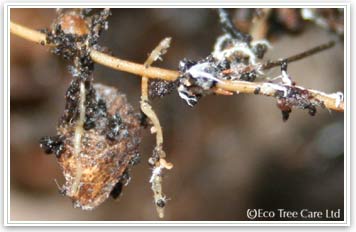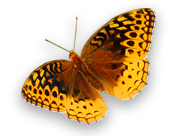Archive page
This website began in the summer of 2003 and so has seen much content over time. We have made a decision that, for now, rather than delete pages that are no longer being updated, or are for services that we no longer offer, we would instead place them in this archive section to serve as a portfolio, library & as a history
Mycorrhiza - The Biology
A Study - What are Mycorrhiza and why are they important?
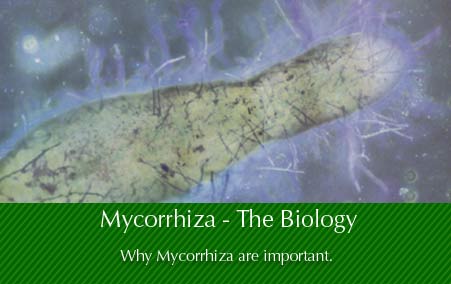
Image above reproduced by kind permission Shigo and Trees, Associates LLC
What is a mycorrhiza?
A mycorrhiza is what is formed when a fungus and a plant root combine. This combination is termed a mycorrhizal association.
It is important to understand that a mycorrhiza is
neither a root nor a fungus but a distinct and separate
entity that is created by the coming together of the
two. The fungus grows with the root and behaves in
every way as if it is actually an external tissue
of the root. It is literally a ‘fungus root’
derived from the combination of two Greek words; mykes
= mushroom or fungus and rhiza = root.
Further to this the fungus part of the mycorrhizae also grows out a very fine network of cotton-like strands, almost like roots themselves. This network consists of individual strands called hyphae. These strands of hyphae collectively form a huge network termed a mycelium network. This mycelium network is easily seen by turning over rotting leaves in a woodland. The mycelium network is the white velvety coating on the rotting vegetation; the larger strands are the mycelium.
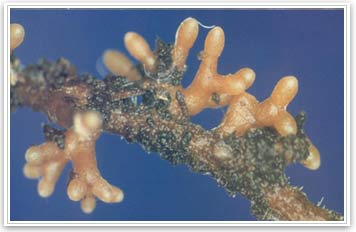
Exposed Mycorrhizae
coating a fibrous root
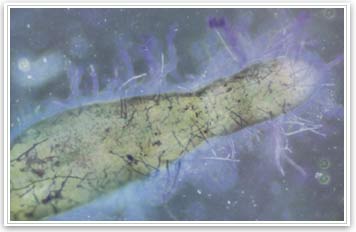
Mycorrhizae tip showing its hypha
Image above reproduced by kind permission Shigo and Trees, Associates LLC
The relationship
The association between the
fungus and the root is a symbiotic one, in which
both the plant and the fungus benefits from the
relationship. The fungus has a relatively constant
and direct access to sugars produced by the plant
in photosynthesis, such as glucose. In return, the
plant gains the use of the mycelium's extremely
large surface area to absorb water and inorganic
mineral nutrients from the soil. The mycorrhizal
fungus coating the root also provide a protection
against external disease causing pathogens.
It has been stated that a tree gives up 25% of its
products of photosynthesis to the fungus to maintain
the mycorrhizal association. But this is much less
energy than it would be required to use if it tried
to establish a comparable network of fibrous roots.
The close association of the roots of trees with
certain fungi was described as long ago as 1885
by a German forester, Albert Bernhard Frank in a
paper called “On the Nourishment of Trees
through a Root Symbiosis with Underground Fungi
(1885)”. However it is only within the last
30 years that scientists have begun to realise that
far from being the exception, such relationships
are actually the norm in the plant kingdom. Research
has shown that in the wild, more than 95 percent
of higher plant species have this fungal association
occurring within their root systems. There are exceptions,
notably brassicas, such as cabbages, and poppies
among others.
Phosphate is essential for plants it is used in
the healthy growth of roots. Plants, it seems, are
incapable of taking up phosphate in the soil alone.
However the mycelium of the mycorrhizal fungus can
access this locked up phosphorus and make them available
to the plants that they are colonizing. Mycorrhizae
are especially beneficial for plants in nutrient-poor
soils. They are able to cover a much larger range
than the roots and so can find the relatively low
concentration of nutrients that are present and
make these available to the plant.
Some trees are ‘obligate’. They must
have a mycorrhizal association to survive. E.g.
Oaks, beech, pine. It is thought that when these
obligate species start to germinate, the energy
contained within the seed is enough to sustain them
for the initial growth into sapling trees. If by
the time that this energy store is exhausted they
have not entered into a mycorrhizal association
with a beneficial fungus then they will gradually
weaken and die.
Others are ‘facultative’. They don’t
require an association but grow much better with
it.
E.g. Birch, aspen, maples. Facultative tree species
are commonly the pioneer species, meaning those
trees which are capable of colonising new areas,
thus setting up a woodland environment ready for
the obligate species to move in.
Under less-than-ideal conditions, studies have shown
that the efficiency of mycorrhizal roots can make
the difference between life and death. Plants with
mycorrhizal root systems are better able to resist
stresses such as drought, heat, and even diseases.
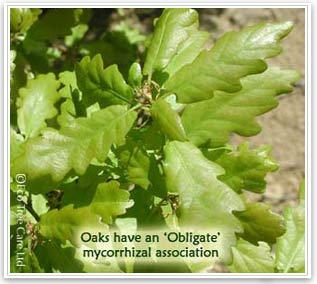
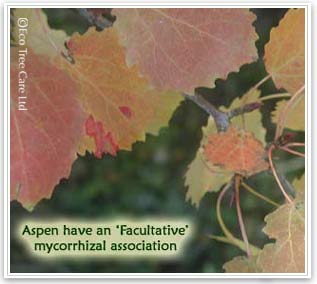
Trees with an established
mycorrhizal association are likely to be more resistant
to disease because of the greater supply of nutrients
and also that the mycorrhiza already occupy areas
on the root that otherwise may be openly vulnerable
to pathogenic organisms. It is also reported that
many mycorrhizal fungi secrete antibiotics, protecting
roots from pathogenic fungi such as Phytophthora
and Armillaria, nematodes (small invasive worms)
and bacteria.
Plants grown in sterile soils and growth media often
perform poorly without the addition of spores or
hyphae of mycorrhizal fungi to colonise the plant
roots and aid in the uptake of soil mineral nutrients.
The absence of mycorrhizal fungi can also slow plant
growth in early planting or on degraded landscapes
Structures and functions
In a mycorrhizal association the fungus may colonize
the roots of a host plant either intracellularly
or extracellularly, as explained below.
There are basically two distinguishable types of
mycorrhizal fungi; ectomycorrhizae (EM) and endomycorrhizae
(AM). They have associations with different plant
species.
Ectomycorrhizae (EM)
With trees, the most common types are ectomycorrhizae
or EM. Ectomycorrhizae means that most of its structure
is outside the cells of the root (extracellularly).
The mycorrhizae form a visible sheath over the surface
of the roots with hyphae which grow into the tree
root but in between the cells. These hyphae form
a characteristic structure known as a Hartig net.
The hyphae do not physically penetrate the cell
membrane. Most EM fungi also produce fruiting structures
like mushrooms and puffballs.
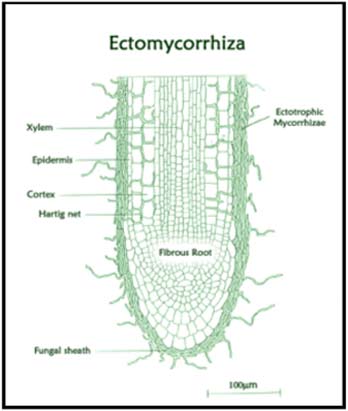
Endomycorrhizae (AM)
The other major type is endomycorrhizae
which have most of their structure inside the root,
also known as arbuscular mycorrhizae or AM. They
are more primitive fungi than the EM type, making
up only 150 of the estimated 6,000 mycorrhizal fungi
species. However, AM fungi is the most abundant
found on 65 percent of plant families, including
grasses, herbaceous plants and woody species, with
most colonising a wide range of plants.
Endomycorrhizae are rare in deciduous trees, but
do occur in some conifers (Thuja, Cypress, Juniper,
Redwood, Swamp cypress).
The arbuscule is a part of the fungus that is tree-like
in structure and penetrates the cell walls of the
root. The result is a large surface area across
which the plant and fungus can exchange substances
to mutual benefit. The hyphae do not actually penetrate
the cell membrane but they do ‘invaginate’
the cell wall.
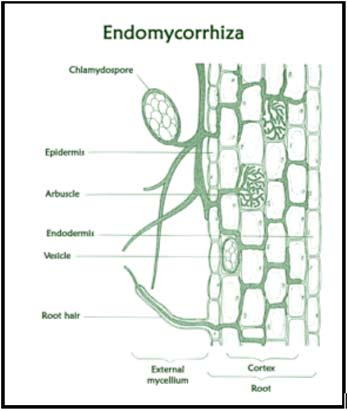
Their microscopic structure makes AM fungi difficult to see and they do not form above-ground fruiting bodies. For this reason they were missed by Albert Frank initially having been discovered more recently. More than 90% of vascular plants are thought to associate regularly with them.
Mycorrhizal Inoculation
Clearly, Mycorrhiza play an essential role in plant survival. It is for this reason that when planting trees, either as single tree planting, a woodland planting scheme or a native hedge planting project it is highly beneficial to introduce mycorrhiza directly to the roots and the soil so that the mycorrhizal association can occur immediately - this technique is called mycorrhizal inoculation.
See Mycorrhizal Inoculation for full details
Further Reading
Tree health and ectomycorrhizal fungal communities ( Forest Research - Forestry Commission)
